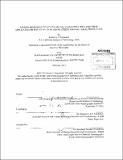Marine microbial intact polar diacylglycerolipids and their application in the study of nutrient stress and bacterial production
Author(s)
Popendorf, Kimberly J. (Kimberly Julia)
DownloadFull printable version (17.43Mb)
Other Contributors
Woods Hole Oceanographic Institution.
Advisor
Benjamin A.S. Van Mooy.
Terms of use
Metadata
Show full item recordAbstract
Intact polar diacylglycerolipids (IP-DAGs) were used to study microbial dynamics in the surface ocean. IP-DAGs from surface ocean seawater were quantified using high performance liquid chromatography-mass spectrometry (HPLC-MS), after first developing a sensitive, high throughput molecular ion independent triple quadrupole MS method for quantification. Using this analytical technique I examined the distribution of the nine most abundant classes of IPDAGs across the Mediterranean, and found that phospholipids as a percent of total IP-DAGs correlated with phosphate concentration. Furthermore, phospholipids were a higher percent of total particulate phosphorus where phosphate was higher, ranging from 1-14%. Thus IP-DAGs can play not only a significant but also a dynamic role in defining planktonic nutrient needs and cellular C:N:P ratios in the environment. Additionally, microcosm incubations were amended with phosphate and ammonium, and in the course of several days this elicited a shift in the ratios of IP-DAGs. This study was the first to demonstrate the dynamic response of membrane lipid composition to changes in nutrients in a natural, mixed planktonic community, and indicated that the change in IP-DAG ratios in response to changing nutrients may be a useful indicator of microbial nutrient stress. In the surface waters of the western North Atlantic I used three experimental approaches to identify the microbial sources of the nine most abundant classes of IP-DAGs. Phytoplankton are the primary source of one class of sulfolipid, sulfoquinovosyldiacylglycerol, and one class of betaine lipid, diacylglyceryl-trimethyl-homoserine, while heterotrophic bacteria are the dominant source of the phospholipids phosphatidylglycerol and phosphatidylethanolamine. In regrowth experiments in the Sargasso Sea and the North Pacific I demonstrated that phospholipid specific production rate is representative of heterotrophic bacterial cell specific growth rate. I measured phospholipid specific production rate and bacterial production rate using uptake of 3H-leucine (³H-Leu) and 3H-thymidine (³H-TdR) across the North Atlantic, across the Mediterranean, and in the North Pacific subtropical gyre. I found that phospholipid specific production rates estimate heterotrophic bacterial cell specific growth rates that are on the order of 1 per day, an order of magnitude faster than cell specific growth rates suggested by uptake of ³H-Leu and ³H-TdR.
Description
Thesis (Ph. D.)--Joint Program in Oceanography/Applied Ocean Science and Engineering (Massachusetts Institute of Technology, Dept. of Biology; and the Woods Hole Oceanographic Institution), February 2013. "February 2013." Cataloged from PDF version of thesis. Includes bibliographical references.
Date issued
2013Department
Joint Program in Oceanography/Applied Ocean Science and Engineering; Woods Hole Oceanographic Institution; Massachusetts Institute of Technology. Department of BiologyPublisher
Massachusetts Institute of Technology
Keywords
Joint Program in Oceanography/Applied Ocean Science and Engineering., Earth, Atmospheric, and Planetary Sciences., Woods Hole Oceanographic Institution.